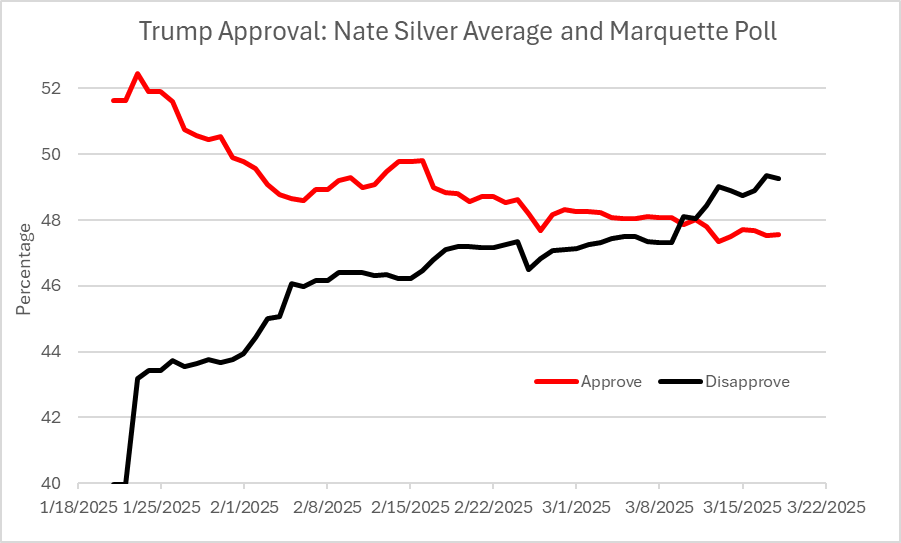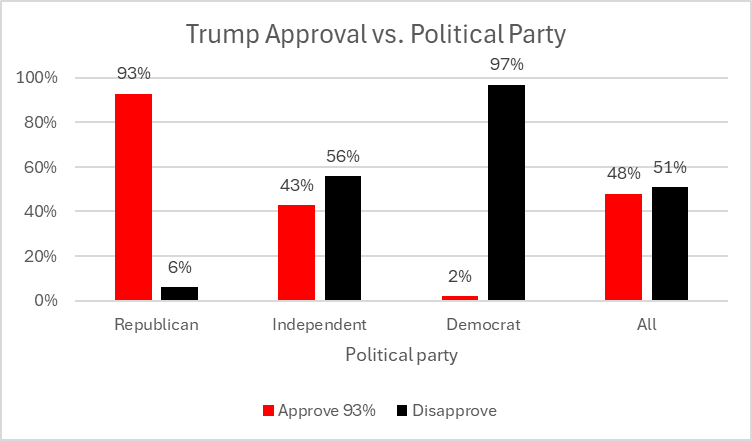Measuring Trump’s Approval Rating
Declining both nationally and in Wisconsin. By how much?
In the runup to last year’s presidential election, various sites appeared that combined the results of numerous public opinion polls with the aim of getting a better picture of which candidate was ahead and which behind. In many cases the poll aggregators also weighted each poll to reflect pollsters’ historical accuracy, giving more weight to the more accurate ones.
The chart below shows the output from the Silver Bulletin. The red line shows the percentage of people who say they approve of Donald Trump, using Silver’s model to combine the results of many polls. The black line shows the percentage who disapproved of Trump.
The chart shows that following Trump’s inauguration, his approval line was substantially above his disapproval line, at about 52% compared to 40%. The two lines eventually cross by March 10 or so, and now there are slightly more approvals than disapprovals.
A second active aggregator is a site called Real Clear Politics. The next figure comes from a screenshot of that site between February 16 and March 16. Although it differs from the Silver pattern, it follows the same overall pattern, with a decreasing approval line and an increasing disapproval line that eventually cross.
A poll taken by the Marquette Law School between March sixth and ninth is the only assessment of sentiments among Wisconsin voters, as opposed to national voters, taken since Trump’s inauguration. It shows Wisconsin voters may have begun turning against Trump slightly sooner than national voters as measured by Silver’s aggregation results, with more Wisconsin voters disapproving than approved of Trump, as shown in the graph below.
The Marquette poll results confirm that we are living in very polarized times. The graph below shows how Trump approval varies by party choice. Ninety-three percent of self-described Republicans said they approved of Trump, compared to only 2% of Democrats. The effect was even stronger with voters who disapproved of Trump: 97% of Democrats disapproved of Trump compared to 6% of Republicans.
Comparing the graph above with the next graph suggests that there is some, but very small evidence that the overwhelming support for Trump among Republicans has not completely translated into support for Elon Musk’s Department of Government Efficiency (DOGE). As is well known by now, DOGE has been busy firing federal employees in order to save funds to pay for lowering taxes on people with the highest incomes.
In the chart above, 93% of Republicans approved of Trump, but in the chart below 88% agreed that Doge is “properly carrying out Trump’s agenda by taking control of government agencies and shutting down programs.” The 6% of Republicans who disapproved of Trump in the first chart were joined by another 5% of Republicans who believed DOGE was “disrupting required programs.”
This suggests that DOGE’s excesses and meanness are starting to resonate with some Republicans. Even if so, this effect is a small one.
One pattern that appears time and again throughout the Marquette poll results is the difference in results due to gender. Generally women prefer the anti-Trump side of an issue by about ten percentage points. As the next graph shows, a majority of men approve of Trump, yet a majority of women disapprove.
Over the years, multiple polls have found that immigration and the economy are the two issues that do the most for Trump. A recent survey (taken March 6-9), and sponsored by CNN asked respondents, “Do you approve or disapprove of the way Donald Trump is handling” several issues. The next graph shows the responses. In this case the only issue that helps Trump is immigration. On the economy, which was considered Trump’s second best issue after immigration, Trump’s management is rejected 44% to 56%. The worst for Trump is tariffs.
The polls show President Trump slipping in popularity in part because of the meanness of the mass firings of government employees, many of whom were veterans. If this polling trend continues, will Trump back off? Or will he react by accelerating his violations of the U.S. Constitution to grab more power?
If you think stories like this are important, become a member of Urban Milwaukee and help support real, independent journalism. Plus you get some cool added benefits.
Data Wonk
-
Why Is Trump Targeting Veterans?
 Mar 12th, 2025 by Bruce Thompson
Mar 12th, 2025 by Bruce Thompson
-
How Vulnerable Is Wisconsin to Federal Firings?
 Mar 5th, 2025 by Bruce Thompson
Mar 5th, 2025 by Bruce Thompson
-
How Fair Are Wisconsin’s Taxes?
 Feb 26th, 2025 by Bruce Thompson
Feb 26th, 2025 by Bruce Thompson





























Excellent analysis Bruce. It is easy to understand and very credible. It would be good to see how independent persons who voted for Trump would think about him at this point it time.
The summary of the first graph seems reversed. (The two lines eventually cross by March 10 or so, and now there are slightly more approvals than disapprovals.)
The graph “Trump Approval vs. Political Party” is the the most disturbing. How can 93% of Republicans approve of what is going on? IMHO it shows a poor thought process, an ignorance of Civics, and no interest in even being polite.
I keep asking the questions, “To what end?”, “Is the regime demonstrating how we should all act with respect to our laws?”, and “Is the daily use of high-cost lawyers by the regime a cost-saving measure?”.
In the long run, reducing employment and education will result in an economic downturn and lower productivity. Of course, the result will show up on the next administration’s watch.
Great work, Bruce – thank you for this!!!!!
The federal debt is a problem.
I’m also concerned with lowering educational standards and our students’ failures. Does spending money on the Department of Education or teachers improve education? Should there be a limit on the amount of money a Superintendent makes?
There seems to be a lack of accountability. Why do US Military General Officers make more money from the US Government (our tax dollars) than they did when they were on active duty? What about privatized family housing and the waste there? The military is now guarding the border. Why wasn’t the active military helping with the fires in California?
All of the money wasted . . failure in Afghanistan . . .
Why isn’t the US Military helping in VA Hospitals? Increase the number of medical in the active military? Support Ukraine with medical care.
What has been done to reduce the national debt?
I cannot disagree with most of the expenses outlined by robertm60a3.
However, deficit is income less expenses. When we decreased income with a tax cut, we increased yearly deficit. Most rational publications espouse that allowing the 2018 tax cut to lapse will decrease the yearly deficit and reduce the growth of the national debt.
Publications such as:
https://www.americanprogress.org/article/tax-cuts-are-primarily-responsible-for-the-increasing-debt-ratio/
are helpful for understanding the issues.
We have a choice:
**allow the 2018 tax cut to lapse and reduce the deficit and maintain essential services
or
**maintain the 2018 tax cut (benefitting primarily the rich), and then reducing expenses by eliminating essential services, thus hurting those who earned and/or need these services
Living together in the world community is combined practicality and morality – and graciousness toward others.
Congress should allow the 2018 tax cuts to expire. There could be some positive aspects to not taxing Social Security Benefits.
The problem is Congress (Representative Fitzgerald). Congress can’t even pass the budget. How does that happen? Representative Fitzgerald is reelected? People keep voting for Representative Fitzgerald.
Education is important. What we’ve been doing isn’t working. Is it smart to keep doing the same thing?
Look at the opioid epidemic. How was that allowed to happen? “American Overdose” by Chris McGreal. Then there is “Fat Leonard” by Craig Whitlock. Here, senior US Navy Officers receive full retirement pay after accepting bribes.
There are cuts that cost money. Cutting funding for Medicate may mean the disabled don’t have the care needed to make them work-ready. It’s cheaper to care for someone in their home than in an institution.
Loaning money is better than giving it away.
Just frustrated. . . I’m not sure how this article helps. It would be helpful to report – weekly the number of people shot in Milwaukee and what those in Congress are doing about the problem. Same for reducing the national debt – what is being done?
We can try taxing those with incomes in excess of $500,000.00 at an increased rate. They drive the same roads, etc. They should pay substantial taxes as they make substantial salaries compared to the folks who simply “work”.